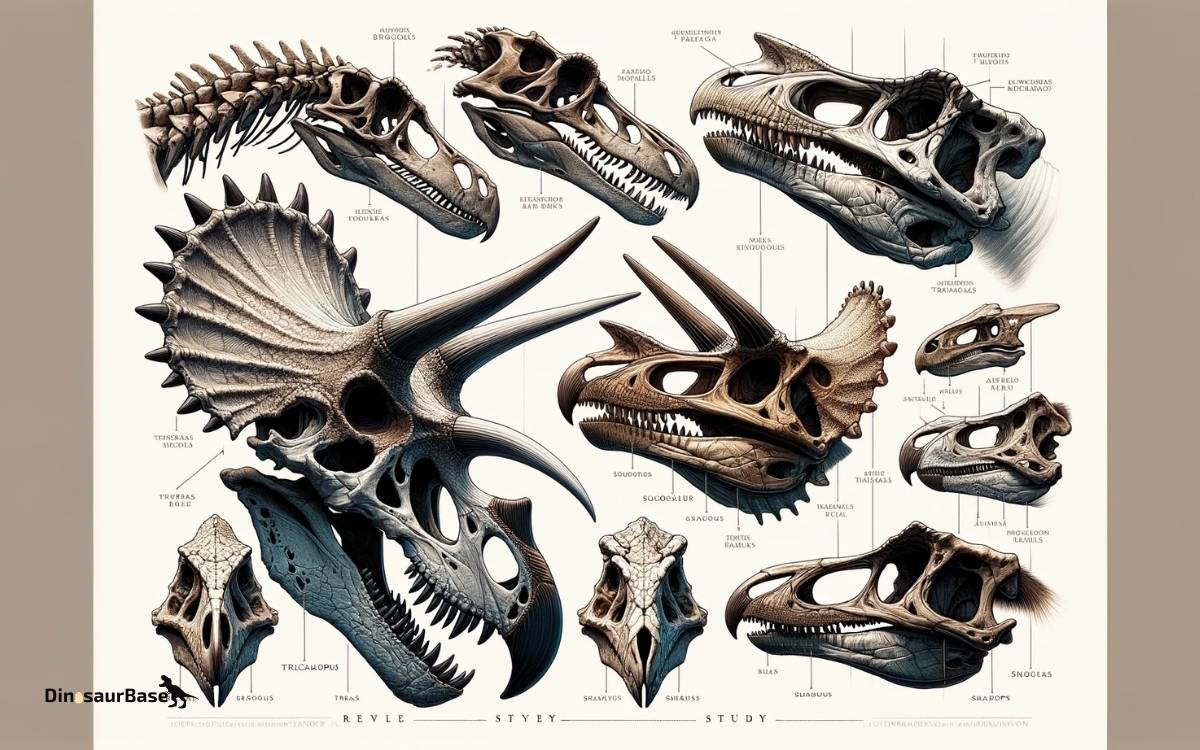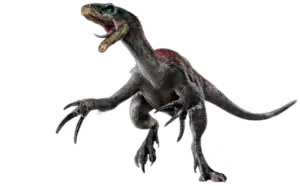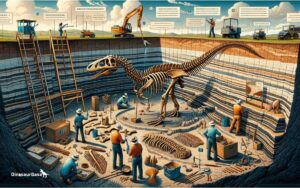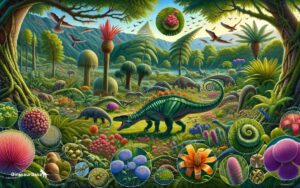What Makes Achelousaurus Skull Unique? A Comparative Study
The Achelousaurus skull is notable for its distinctive nasal bosses and lack of elongated brow horns. It contrasts sharply with the well-horned skulls of related ceratopsians.
Achelousaurus, a fascinating species from the Late Cretaceous period, possesses a skull that intrigues paleontologists and dinosaur enthusiasts alike.
Its genus name, derived from the Greek mythological river god, Achelous, reflects the unique horn configuration that resembles injuries sustained in mythological battles.
This ceratopsian, discovered in Montana’s Two Medicine Formation by a team led by Jack Horner, stands out due to its evolutionary implications.
The nasal bosses—bumpy, pronounced features on its snout—are a distinct departure from relatives like the Triceratops, which sport elongated horns.
These differences provide insight into ceratopsian diversity and evolutionary changes within the group, offering a richer understanding of dinosaur morphology and behavior.

Unraveling The Distinct Features Of Achelousaurus Skull
The Achelousaurus, a late Cretaceous herbivore, captivates paleontologists with its skull. This dinosaur’s skull presents unique adaptations and raises questions about its lifestyle and behavior.
Understanding the distinct features of the Achelousaurus skull offers insights into its mysterious past.
Unique Horn And Frill Configuration
Achelousaurus stands out with an extraordinary set of horns and frill. The skull features two prominent horns above the eyes, though smaller compared to some relatives.
Its remarkable frill, extended from the back of the skull, showcases a distinct pattern of bumps and grooves.
- Nasal boss: Instead of a horn, it has a bony lump on the nose.
- Parietal fenestrae: Openings in the frill reduce weight, possibly aiding in head movement.
Implications Of Skull Shape On Behavior
The Achelousaurus skull hints at unique behaviors. The nasal boss could suggest head-butting activities.
The frill’s ornamentation might have been a display feature, indicating social interactions within species or deterring predators.
| Feature | Possible Behavior Implication |
|---|---|
| Nasal Boss | Head-butting, dominance displays |
| Frill | Social signaling, species identification |

Credit: en.wikipedia.org
A Look Into Ceratopsid Anatomy
Ceratopsians, known for their impressive horns and frills, have captured our imagination. These herbivorous dinosaurs roamed the Earth during the Late Cretaceous period. Their anatomy, especially the skull, offers clues about their lifestyle and behavior.
One such intriguing member of this group is Achelousaurus, whose skull has unique characteristics that stand apart from its relatives.
Let’s dive into the fascinating features of ceratopsid anatomy that make Achelousaurus so special.
Comparing Achelousaurus To Other Ceratopsians
Distinctive Features of Achelousaurus:
- Bosses instead of horns above eyes
- Modified nose horn
- Less prominent frill
These traits make Achelousaurus’ headgear quite different from famous relatives like Triceratops. Triceratops boasted large, well-defined horns above its eyes and an imposing frill, features that helped it stand out.
Scientists study these differences to understand more about ceratopsid diversity. They compare the skulls using measurements and shape analyses.
Evolutionary Context Of Skull Variations
Skull variations among ceratopsians didn’t just happen by chance. They evolved over millions of years.
These changes likely relate to different factors:
- Dietary needs: Different plants might have required different tools for eating.
- Display features: Horns and frills might have helped in attracting mates or scaring off rivals.
- Environmental adaptation: Changes in environment could lead to changes in skull structure.
Achelousaurus shows an amazing mix between its less embellished skull and the more ornate skulls of its cousins.
This combination reveals that evolution works not in straight lines, but in a branching web of changes with multiple outcomes.
Analyzing Fossil Records
The quest to uncover the mysteries of prehistoric life takes us deep into the realm of paleontology, where fossil records serve as the crucial pieces of evidence in revealing the lives of extinct creatures.
Among these ancient beings, the Achelousaurus stands out thanks to its unique skull morphology.
Through meticulous analysis of fossil records, scientists gain insights into this fascinating dinosaur which once roamed the Earth.
Key Achelousaurus Discoveries
Exploring the significant findings of Achelousaurus fossils, several skeletons have emerged that are crucial for scientific study. Each discovery brings with it a wealth of information waiting to be deciphered by experts.
- 1995 – The First Encounter: Paleontologist Scott D. Sampson discovers the first known Achelousaurus skull.
- Subsequent Discoveries: More specimens are unearthed, highlighting variations within the species.
- Insight into Habitat: Fossils suggest Achelousaurus inhabited floodplains during the Late Cretaceous period.
Techniques In Studying Fossilized Skulls
To unravel the secrets locked in the stony remains of Achelousaurus, scientists apply advanced techniques that allow a glimpse into its past.
- CT Scanning: Creates detailed 3D images of skull interiors without damaging fossils.
- Microscopy: Examines the surface for fine details in structure and wear.
- Comparative Analysis: Compares skull features with other ceratopsians to understand evolutionary relationships.
| Technique | Purpose | Outcome |
|---|---|---|
| CT Scanning | Interior visualization | Detailed 3D skull mapping |
| Microscopy | Surface examination | Identification of wear patterns |
| Comparative Analysis | Evolutionary study | Insights into species development |
Through these techniques, each Achelousaurus skull tells a new story, contributing richly to our understanding of the diverse tapestry of life that once adorned our planet.
Functional Morphology In Achelousaurus
Achelousaurus, a species of ceratopsian dinosaur, exhibits unique features in its skull structure. These features suggest specialized functions. Scientists study the skull to understand how this dinosaur lived.
Diet And Feeding Mechanisms
The skull of Achelousaurus reveals clues about its diet. The skull structure suggests that it could chew plants well. Achelousaurus had a beaked mouth for clipping vegetation.
- Wide cheekbones: They helped to hold strong jaw muscles.
- Flat teeth:They were perfect for grinding plants.
Dental wear patterns show that Achelousaurus ate tough plants.
Defensive Adaptations Speculated From Skull Structure
The skull of Achelousaurus was not just for eating. It also helped protect it. The skull had hardened areas called bossing.
- Bosses: Bony structures on the skull acted as a shield.
- Frill: The frill protected its neck and might have scared enemies.
You can tell Achelousaurus was strong in defense. It could face tough predators.
The Role Of Achelousaurus In Its Habitat
The Achelousaurus was a remarkable creature. It thrived millions of years ago. Its skull reveals how it lived.
The habitat of the Achelousaurus shaped its existence. This dinosaur needed special skills to survive. Let’s explore how the Achelousaurus fit into its world.
Interactions With Predators And Competitors
The Achelousaurus skull suggests it was a target of predators. Sharp horns and a large frill protected it.
Predators like T-rex a worthy adversary. The Achelousaurus also faced competition for food. Other herbivores wanted the same plants.
- Sharp horns for defense
- Large frill to look intimidating
- Strong muscles in the neck
Reconstructing Ancient Ecosystems Through Skull Analysis
Scientists study skull fossils to understand ecosystems. The Achelousaurus skull holds clues. It helps us picture ancient environments.
Diet, behavior, and lifestyle secrets are locked inside these fossils. Each fossil discovery adds a piece to the puzzle of the past.
| Skull Feature | Ecosystem Insight |
|---|---|
| Teeth | Types of plants eaten |
| Fossil location | Where it lived and roamed |
| Horns and frill | Defense mechanisms |
Continuing The Journey In Paleontology
The field of Paleontology never stands still, with each discovery adding depth to our understanding of the ancient world.
When it comes to the unique features of the Achelousaurus skull, the past finds its place in present research, guiding us toward future expeditions. This dinosaur, named by Paleontologist Scott D. Sampson in 1995, catapults scientists into an exciting realm of prehistoric life.
Current Research And Future Excavations
The Achelousaurus skull is a marvel with its distinctive combination of horns and a bony frill. Its one-of-a-kind anatomy presents many unanswered questions for researchers.
Studies focus on the functions of its cranial features, which might include defense, display, or species recognition.
- Analysis of bone structure
- Comparative morphology with related species
- Examination of growth patterns
Future digs aim to uncover more fossils to bridge gaps in the Achelousaurus timeline. They will further our grasp on how this dinosaur evolved and interacted within its environment.
Technological Advancements In Paleontological Studies
Breakthroughs in technology transform how scientists study fossils. Advanced imaging techniques, like CT scans, allow researchers to peer inside the dense rock encasing a fossil without damaging it.
- 3D printing of fossils for detailed analysis
- CT scans for non-invasive examinations
- Software for simulating growth and behavior
These innovations make it possible to theorize about soft tissues and muscles that the Achelousaurus skull once supported.
This insight is invaluable for constructing accurate life-like models. Excitement grows as these tools promise to shed light on countless mysteries of ancient life.
How Does the Uniqueness of Achelousaurus Skull Contribute to Successful Fossil Excavation?
The unique features of the Achelousaurus skull, such as its nasal bosses and elongated snout, make it easily recognizable during achelousaurus fossil excavation techniques. These distinguishing characteristics help paleontologists identify and carefully extract the skull, contributing to successful and accurate fossil excavation.
Frequently Asked Questions For What Makes Achelousaurus Skull Unique? A Comparative Study
Who Discovered The Achelousaurus?
Paleontologist Scott Sampson discovered the Achelousaurus in 1987 in Montana’s Two Medicine Formation.
What Did Achelousaurus Eat?
Achelousaurus was a herbivore, primarily feeding on plants for sustenance.
What Type Of Skull Does A Dinosaur Have?
Dinosaurs had diverse skull types, typically categorized as diapsid, featuring two temporal openings on each side. These structures allowed for strong jaw muscles and varied diets.
What Defines The Achelousaurus Skull Shape?
The Achelousaurus skull is distinct due to its combined features of horns and a bony frill. Its nasal horn and two parietal horns positioned above the eyes resemble those of Triceratops but are stubbier. The bony frill, which extends from the skull, provides attachment for powerful jaw muscles.
Conclusion
The Achelousaurus skull fascinates paleontologists and enthusiasts alike. Its distinctive features set it apart in the dinosaur family tree.
This comparative study highlights the unique horns and frill, shedding light on its evolutionary journey. Keep exploring such marvels to grasp our planet’s rich prehistoric legacy.
Stay curious, keep digging, and treasure the past!





